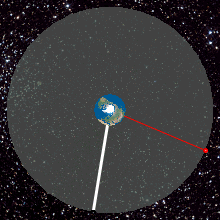Geostationary orbit
Geostationary Orbit (GEO) is a circular orbit directly above the Earth's equator at a height of approximately 35,786 kilometers (22,236 miles). At this altitude, the orbit's period matches the Earth's rotation period of 24 hours, allowing the satellite to appear stationary relative to the Earth's surface. This unique characteristic makes geostationary orbits particularly valuable for communication satellites, weather satellites, and for certain military applications.
Characteristics[edit | edit source]
A satellite in a geostationary orbit appears to be in a fixed position to ground observers, enabling reliable communication with a specific area of the Earth's surface. This is advantageous for broadcasting, telecommunications, and internet services, as well as for meteorology and Earth observation. However, launching a satellite into GEO requires a significant amount of delta-v (change in velocity) and precise positioning to maintain the orbit, making it more complex and costly compared to lower Earth orbits.
Applications[edit | edit source]
Communication Satellites[edit | edit source]
The majority of satellites in geostationary orbit are used for telecommunications, including TV broadcasting, satellite phone services, and secure military communications. These satellites can cover large portions of the Earth, making them ideal for broadcasting to and from remote locations.
Weather Satellites[edit | edit source]
Geostationary weather satellites, such as those operated by the National Oceanic and Atmospheric Administration (NOAA), provide continuous monitoring of weather patterns, storm development, and environmental conditions. This constant observation is crucial for timely weather forecasting and disaster response.
[edit | edit source]
While not primarily used for navigation, geostationary satellites can augment Global Navigation Satellite System (GNSS) constellations by providing additional signals for improved accuracy and reliability, especially in equatorial regions.
Challenges[edit | edit source]
Despite their advantages, geostationary orbits also present challenges. The limited "real estate" in this orbit can lead to overcrowding, requiring careful coordination to avoid interference between satellites. Additionally, the high altitude increases exposure to solar radiation and charged particles from the Van Allen radiation belt, necessitating robust satellite design to ensure longevity and reliability.
Environmental Considerations[edit | edit source]
The increasing number of satellites in geostationary orbit raises concerns about space debris and long-term sustainability. Satellites at the end of their operational life are typically moved to a higher "graveyard orbit" to reduce the risk of collisions. However, this practice and the growing demand for GEO slots highlight the need for improved space traffic management and debris mitigation strategies.
See Also[edit | edit source]
This article is a space- or spaceflight-related stub. You can help WikiMD by expanding it!
Search WikiMD
Ad.Tired of being Overweight? Try W8MD's physician weight loss program.
Semaglutide (Ozempic / Wegovy and Tirzepatide (Mounjaro / Zepbound) available.
Advertise on WikiMD
|
WikiMD's Wellness Encyclopedia |
| Let Food Be Thy Medicine Medicine Thy Food - Hippocrates |
Translate this page: - East Asian
中文,
日本,
한국어,
South Asian
हिन्दी,
தமிழ்,
తెలుగు,
Urdu,
ಕನ್ನಡ,
Southeast Asian
Indonesian,
Vietnamese,
Thai,
မြန်မာဘာသာ,
বাংলা
European
español,
Deutsch,
français,
Greek,
português do Brasil,
polski,
română,
русский,
Nederlands,
norsk,
svenska,
suomi,
Italian
Middle Eastern & African
عربى,
Turkish,
Persian,
Hebrew,
Afrikaans,
isiZulu,
Kiswahili,
Other
Bulgarian,
Hungarian,
Czech,
Swedish,
മലയാളം,
मराठी,
ਪੰਜਾਬੀ,
ગુજરાતી,
Portuguese,
Ukrainian
Medical Disclaimer: WikiMD is not a substitute for professional medical advice. The information on WikiMD is provided as an information resource only, may be incorrect, outdated or misleading, and is not to be used or relied on for any diagnostic or treatment purposes. Please consult your health care provider before making any healthcare decisions or for guidance about a specific medical condition. WikiMD expressly disclaims responsibility, and shall have no liability, for any damages, loss, injury, or liability whatsoever suffered as a result of your reliance on the information contained in this site. By visiting this site you agree to the foregoing terms and conditions, which may from time to time be changed or supplemented by WikiMD. If you do not agree to the foregoing terms and conditions, you should not enter or use this site. See full disclaimer.
Credits:Most images are courtesy of Wikimedia commons, and templates, categories Wikipedia, licensed under CC BY SA or similar.
Contributors: Prab R. Tumpati, MD

